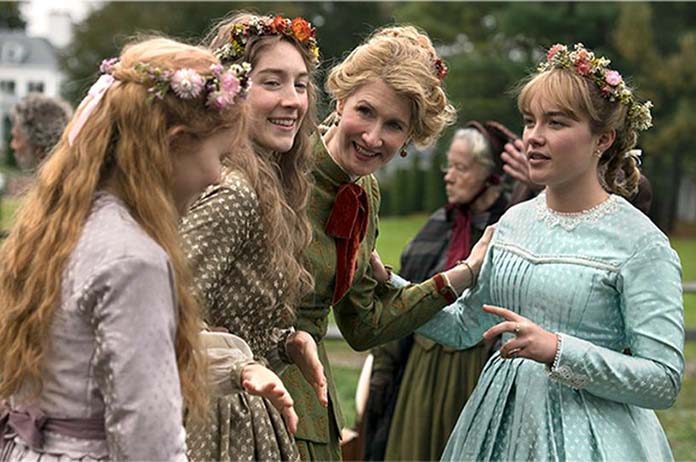WARNING! Spoiler Alert!
Greta Gerwig’s Little Women is fresh, modern and constantly moving –
But was it 2019 or 1994 that did it better?
I remember on a bored evening when I was sick at home, going through my mother’s DVD collection and finding a case with four women, dressed in Victorian style dresses, smiling in a field of flowers. I was into romantic comedies, but I was just starting to get into stories in the Victorian and Georgian eras after having to read Jane Eyre for English class so when I found the DVD, I was curious. It was so charming, cute and Jo had that similar intellectual energy of Jane Eyre; and that was the story of how I fell in love with the 1994 Little Women film.
So, when a new movie of the same title came out, I knew it was something I had to see.
There is a clear difference in cinematography in terms of style which I think comes down to vintage and modern tastes. In the 1994 version, the camera is stiller for longer, has more larger shots to show more of what is happening but with less single focus on finer details. In comparison, the 2019 version moves around a lot and has those tighter shots. The structure itself seems to lean a bit more to TV shows which jumps around between key characters instead of following the perspective of the protagonist through their subjective and more closed story.
While the 1994 film is about a spirited protagonist in a romanticized family drama, the 2019 is fresh, alive and unapologetically raw. It brings feminist themes and stories about women to the forefront. Where the 1994 film is a step back in time, the 2019 Little Women is bringing the story almost to a more modern age.
The film begins at a later point than audiences will be used to. Instead of childhood, the girls are already adults – it starts with Jo and her struggle to make money via her writing and it jumps from there to all the other March sisters – where they are and what their lives are like when they are older and more accomplished.
Jo trying to sell stories, staying at a boarding house where
she wrote.
Amy in Paris, working on her paintings.
Meg is married, with kids and seems to be struggling to get by.
The film then jumps back in time to seven years ago and then back to adulthood. Honestly, I kind of didn’t like the structure and felt like it was jarring, confusing and kept taking you out of the immersion of the narrative. This style is becoming more popular with the success of Game of Thrones, and as TV shows are becoming even more popular than movies, which makes me understand why they did it from a producer perspective.
The time and place jumping works well in establishing a world, but in this case the world is already a familiar place. Watching this story unfold in that format felt a bit like a visual essay of sorts where there was more of a focus on the main ideas and convictions of the main characters, which is a fresh and modern take on the story, but I felt like I didn’t have enough time with the young March sisters. Like they were false while the older versions were real, and those young girls were only remnants, however it’s not fair to judge from structure alone and to make it a little easier, I decided to ask in each important scene…which film did it better?
Jo Meeting Laurie – 2019
Saorise Ronan brings an energy that is a lot more bold and free spirited than Winona Ryder in this scene. Except maybe with listening to her sister’s instructions on how to hide her skirt, she seems more ashamed and generally uncomfortable with the social etiquette and niceties of a fancy ball. I think I really enjoyed the scenes of them dancing and sneaking around outside of the house. It juxtaposes the two from the crowd inside, feeling forbidden just from the unconventional impropriety. It feels more rebellious than ‘safe’, and while they’re also free, it’s a freedom that feels earned and dangerous instead of the natural one of the prior movie. What results is a really cute scene where they dance, in the usual manner that the party goers inside also seem to be doing, moving faster as they pass the windows to try and evade being seen, but later they get sillier and sillier. Which easily shows that Laurie is a man that she can easily vibe with as a friend. Don’t get me wrong; I love Winona’s performance too. It’s what I’d more imagine of a woman of that time.
Amy Burning The Book – 2019
I feel like 2019 pays more attention to it and has more emotion flying around in the fight so I feel like I need to give it to 2019, but I still think 1994 stayed truer to the characters. The scene in 1994 though was also so fast.
This Amy is a lot more complicated. She’s older looking and taller. Burning the book was a calculated moment of anger as she literally burned the pages one by one, whereas 1994 Amy appeared to just kind of throw it in. Florence’s Amy as well explains all her reasoning in detail, in front of all the other sisters. Maybe it all really needed to change just because Amy was older, and she would not be believed or loved at all if one of her flaws was impulsiveness. I’m kind of sad for her character because I feel like one of the defining traits that she had in the story was naivety and childish impulsiveness, whereas instead of her crime maybe being chalked up to youth and jealousy, it’s just more pure pettiness and spite. Florence Pugh does her best and she is cute in those bangs but she’s a 24-year-old playing a 12-year-old, so I think young Amy March might either suffer or shine depending on whether you can believe her. I also feel like Amy is less forgivable with the slow burning of the pages, knowing that she could have stopped herself from doing worse at any moment but didn’t.
Amy Falling Into Ice – 1994
It’s shot better, and there’s that contrast that lingers a little longer, with the two happy friends minding their own business while Amy is nagging for their attention from afar before she falls under. It’s that feeling of not just angering or hurting your sister but realizing what special thing they brought to your life that’s now so wholly out of reach, as well as that fear of that loss or change to your social life/structure because the other people in your life prefer them over you. Saoirse still played a very cold Jo so well in the new film.
Meg Being ‘Daisy’ – 1994
I know the dresses in this version are more old-fashioned, but it was of that era. I think they looked glamorous, and true to the whole debutante in white idea.

This is where some pretty rich girl brings her over, makes her look in the mirror and goes, I’m going to change all of that! The whole makeover thing is more problematic today, of course, but women are not immune from feeling terrible or insecure either. I think it was a good way to also represent the life and things that Meg wished she had, that she might have had if her mother hadn’t married beneath her or if the war hadn’t begun. It was looking into what could have been.
Meg’s isn’t infallible. Her flaw isn’t marrying poor or wanting a family over a career, while that’s always been part of who she is. It’s want or envy. Later when she tells Laurie ‘don’t tell Jo’ and ‘I’ll be good,’ it’s a lot clearer what she’s apologizing for. In 2019, it’s like she’s apologizing for wearing a lot of satin and frills. What? How dare she want to dress feminine. I still really like that pink dress as well, especially when she’s leaning on the lounge chair and it’s drawn out all around her. Who else is getting Hermione at the Yule ball vibes?
Laurie Proposing, Jo Rejecting – 2019
It is shot more beautifully on that hill, with the wind blowing through Saorise’s hair. It’s just so much truer to Jo and focused on who she is. In 2020, it’s also less problematic for the audience today than the 1994 version where he also gives her a kiss, but it looks a little forced.
In 2019, the energy between them is more platonic. Greta Gerdwig also adds some more features about them in the film, and I think it makes them not being together easier to swallow for those that ship them.
Jo at the Boarding House in London – 1994
In the 1994 film, when we see Jo at the boarding house it’s a big step because she was leaving her family to pursue her career against her Aunt’s desire for her to get married. Josephine also says this quote when talking with some boys about women’s rights and it stuck with me.
“Women shouldn’t have the right to vote because women are angels, and men are demons, but because we are human.”
In the 2019 film, it is a setting used to set up Josephine immediately, so I feel like it’s maybe one that’s taken for granted. There’s no ‘breaking the glass ceiling’ feel about it, it’s just Jo’s habitat.
Beth’s Death – 1994
There was a lot that the 2019 was trying to do, and while it gave moments for Beth to take the spotlight, she often didn’t really speak at all. In the 1994 film, Beth gave this really endearing brave speech before she died about enjoying the simple life at home surrounded by family that she had but hating being left behind as her other sisters ventured out into the world getting married or pursuing their careers. The wind and the window was also a great moment, but it might be less relevant to the more secular audience today.
The Ending – 2019
The end was the best part of the film. It is a bit more unique to the books and the previous films, but I think it really does Jo March justice with the kind of character that the original writer wanted her to be. I don’t want to give anything away but I think anyone will be pleasantly surprised with the kind of clever trick Greta Gerwig accomplished.
Summarising thoughts:
Jo was wilder, bolder but also more relatable.
Amy had a lot more focus and screen time in this adaption. She was an intelligent self-aware realist in a house of creative idealists.
Beth just kind of existed to die, like the person buying Jo’s manuscripts dictated about women in stories: they either die or get married.
Meg was cute and motherly but while special attention was given to Jo’s and Amy’s love stories, hers seems mostly skimmed on. We see her get married, have kids and struggle being married to someone poor but we hardly see her and John meet or interact before they get married. Besides the wedding day, I feel like I only see him be sad. Meg loves him because he is kind, but I wish I got to at least see him do one kind thing to prove it.
I felt like Meg mostly got ignored though, whereas she was a bigger character in the other movie. This might just be nostalgia talking; Trini Alvarado played Meg so well.
Besides that, Greta Gerwig’s take on Little Women has its own special takeaways, with changes and touches that make this edition more raw, realistic and alive. While I might have wished for the film to follow a more sequential order to feel more connected to the story, the more important factor for the film seems to be the convictions of the main female characters.
The film honours the name ‘Little Women’ by following women, and in particular I think this one really showcased and contrasted Jo and Amy – reflecting on what strong, ambitious women could look like in those days. But it can also be a little preachy in some areas.
I enjoyed the film. I was a little disappointed but as long as you don’t expect a quaint charming film about young girls in a simpler time without technology, I think you’ll be fine. It’s not Little Women as you remember it, that’s for sure.
Rating: 7.5/10
What did you think? Which film did which scene best? I’ve only also watched the 1994 film but feel free to mention others to? Let us know in the comment section below!
Written by Jessica Guttridge










